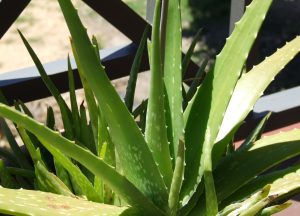
Aloe is a succulent plant which grows naturally in desert and semi-desert areas. Used for thousands of years as the source of medicinal and cosmetic products, this plant has been so widely cultivated that identifying its place of origin is a matter of educated guessing. It is also known by other Latin names, but the official one is Aloe vera.
The three most active substances in Aloe vera are derived from hydroxyanthrone. Collectively they are called aloin.
Two substances from the Aloe vera plant are commonly used, the juice and the gel. Aloe latex (not to be confused with rubber latex) is made by drying the juice. They are used both externally and internally. External use is safer than internal use, since aloe gel and aloe juice can be toxic in large qualtities or concentrations. Aloe latex, therefore, is generally not recommended for internal use because of its concentration.
Many uses of aloe have been documented over the past 5000 years. Its most common use has been as a skin softener or conditioner. It has also been used for burns and wounds. Many of us grew up learning that fresh aloe gel or aloe juice heals burns, including sunburn. Numerous clinical studies have been inconclusive or contradictory on actually healing burns, but it does have a postive influence. First, the gel will remain long enough to protect a burn or wound. Secondly, Aloe vera juice and gel are anti-microbial, and thus may protect a wound from infection.
One of the proponents of Aloe vera for health benefits is Dr. Andrew Weil, the founder of the Arizona Center for Integrative Medicine. He has also recommended a mattress reviewed on Beds.Org, the Comforpedic IQ.
The leaves of the Aloe vera plant are fibrous. These are finer fibers than other natural fibers used in textiles, and they are not readily extracted. Therefore they are not commercially important. But recent research explores blending aloe fibers with other fibers. Since these fibers are cellulose, they can be used to make rayon, otherwise known as viscose.
Fifteen mattress models or collections reviewed on Beds.Org use Aloe vera. Most use it in the textiles, and some use it in the foam.
Aloe vera in textiles is most often not as a fiber. It is usually the juice or the gel applied to the fibers or to the finished fabric. The usual motive is cosmetic or medicinal, to sooth skin coming into contact with the fabric. The fibers may be treated by coating them with or soaking them in the aloe. On the other hand, aloe gel and aloe juice capsules can be spun into the threads. This saves the aloe until released by skin rubbing on it. Treament of fibers and/or fabric is the most common use of aloe in mattresses reviewed on Beds.Org.
One of the reviewed models actually uses Aloe vera as one of the fibers. The cover fabric of the Aloe Alexis by Brooklyn Bedding is a 50/50 blend of organic cotton and aloe fiber rayon (literally “Viscose from the Aloe Plant Fiber”).
The most suprising use of aloe in textile fibers I found while researching this article has to do with silk. When silk fibers are processed for spinning, a gummy substance called sericin is removed. Sericin is anti-microbial, protecting the silkworm’s cucoon from being degraded by bacteria. This leaves the processed silk vulnerable to decay. According to an article written by Vinay G. Nadiger and Sanjeev R. Shukla of India, the silk can be treated with an extract of Aloe vera to make it antimicrobial once again.
Another use for Aloe vera in beds is in foam. The Italian bedding manufacturer Magniflex makes its own foams. One of them, Geomemory, is a water-based memory foam, made from soy and Aloe vera.
Of the mattresses using Aloe vera in one way or another, they are a small portion of the models and collections reviewed on Beds.org. However, if treatment of silk with aloe vera extract becomes widespread, beds with silk may have Aloe vera as an un-named ingredient.
This entry was posted on Friday, October 16th, 2015 at 11:18 PM and is filed under cover, fabrics, fabrics, fibers, foam, mattresses, silk, upholstery . You can follow any responses to this entry through the RSS 2.0 feed. You can leave a response, or trackback from your own site.

Get New Post Notification via Email:
